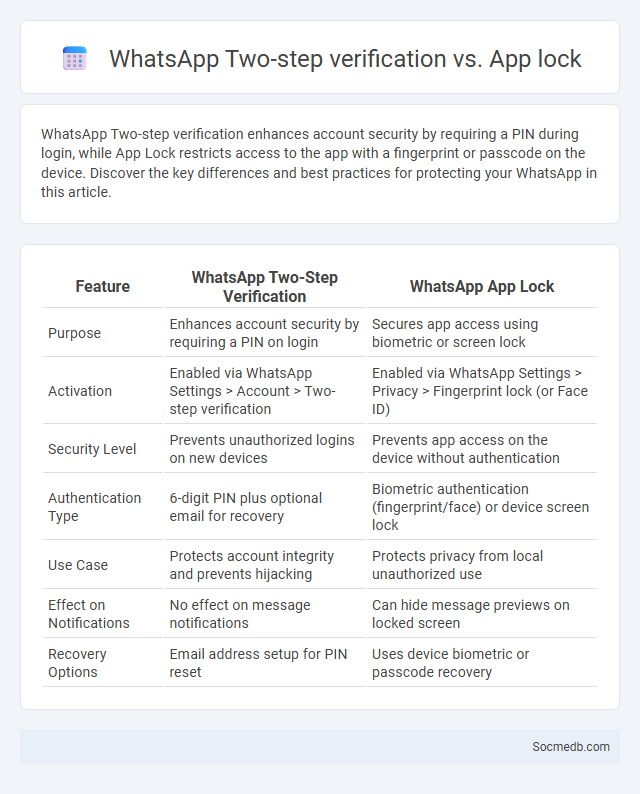
Photo illustration: WhatsApp Two-step verification vs App lock
WhatsApp Two-step verification enhances account security by requiring a PIN during login, while App Lock restricts access to the app with a fingerprint or passcode on the device. Discover the key differences and best practices for protecting your WhatsApp in this article.
Table of Comparison
| Feature | WhatsApp Two-Step Verification | WhatsApp App Lock |
|---|---|---|
| Purpose | Enhances account security by requiring a PIN on login | Secures app access using biometric or screen lock |
| Activation | Enabled via WhatsApp Settings > Account > Two-step verification | Enabled via WhatsApp Settings > Privacy > Fingerprint lock (or Face ID) |
| Security Level | Prevents unauthorized logins on new devices | Prevents app access on the device without authentication |
| Authentication Type | 6-digit PIN plus optional email for recovery | Biometric authentication (fingerprint/face) or device screen lock |
| Use Case | Protects account integrity and prevents hijacking | Protects privacy from local unauthorized use |
| Effect on Notifications | No effect on message notifications | Can hide message previews on locked screen |
| Recovery Options | Email address setup for PIN reset | Uses device biometric or passcode recovery |
Overview of WhatsApp Security Features
WhatsApp employs end-to-end encryption to secure messages, ensuring that only the sender and recipient can read the content, which protects against eavesdropping and unauthorized access. The platform also supports two-step verification, adding an extra layer of account protection by requiring a PIN when registering a phone number. Features like encrypted backups and biometric lock reinforce user privacy and safeguard personal data from potential breaches.
What is Two-step Verification on WhatsApp?
Two-step verification on WhatsApp is a security feature that protects your account by requiring a six-digit PIN in addition to the usual verification code sent via SMS. This extra layer of protection helps prevent unauthorized access, even if someone gains access to your phone number. Enabling two-step verification enhances your account's security and keeps your private messages and data safer from potential threats.
How WhatsApp App Lock Works
WhatsApp App Lock enhances your privacy by requiring biometric authentication or a passcode to access the app, preventing unauthorized users from reading your messages. This feature integrates with your device's security settings, supporting fingerprint, face recognition, or PIN to unlock. By enabling WhatsApp App Lock, you ensure that your private conversations and media remain protected even if your phone is unlocked.
Differences Between Two-step Verification and App Lock
Two-step verification enhances social media account security by requiring users to provide a second form of authentication, such as a code sent via SMS or an authenticator app, preventing unauthorized access even if passwords are compromised. App Lock specifically secures the social media application on a device by requiring an additional password, PIN, or biometric verification before opening the app, protecting the account from unauthorized access at the device level. While two-step verification safeguards against remote hacking attempts, App Lock focuses on physical device security and user privacy.
Advantages of Two-step Verification
Two-step verification enhances social media security by requiring users to provide an additional authentication factor, such as a code sent to their mobile device, beyond just a password. This method significantly reduces the risk of unauthorized account access, protecting personal information and preventing identity theft. Platforms like Facebook, Instagram, and Twitter widely support two-step verification to ensure safer user experiences and safeguard digital identities.
Benefits of Using WhatsApp App Lock
Using WhatsApp App Lock enhances privacy by preventing unauthorized access to private chats and multimedia files, ensuring personal conversations remain secure. It strengthens data protection against potential hacks and accidental phone sharing, providing users with peace of mind. This feature supports secure communication, maintaining confidentiality in social media interactions.
Common Misconceptions About WhatsApp Security
WhatsApp security is often misunderstood, with many users believing that all messages are completely private when in reality, metadata like timestamps and contact information can still be accessed. End-to-end encryption ensures that only you and the recipient can read message content, but backups stored on cloud services may not be encrypted, posing potential risks. It is crucial to regularly update the app and review privacy settings to maintain optimal security on your WhatsApp account.
Use Cases: When to Use Two-step Verification vs App Lock
Two-step verification enhances account security by requiring users to provide a second form of authentication, making it ideal for protecting social media profiles from unauthorized access and phishing attacks. App Lock adds an extra layer of privacy by restricting access to specific social media applications on a device through PINs or biometric data, suitable for shared or public devices. Combining both features maximizes protection by securing both the login process and app access, ensuring comprehensive defense against data breaches and privacy invasions.
Tips for Maximizing WhatsApp Account Security
Enable two-step verification on your WhatsApp account to add an extra layer of protection beyond the standard SMS verification. Regularly update the app to access the latest security patches and features that prevent unauthorized access. Avoid sharing your verification code with anyone and review privacy settings to control who can see your personal information and status updates.
Choosing the Right Security Feature for Your Needs
Choosing the right security feature for your social media accounts depends on understanding the specific threats you face, such as phishing, account hacking, or privacy breaches. Multi-factor authentication offers a strong layer of protection by requiring multiple forms of verification, while privacy settings control who can see your posts and personal information. Evaluate these options carefully to match your security needs and protect your online presence effectively.
 socmedb.com
socmedb.com